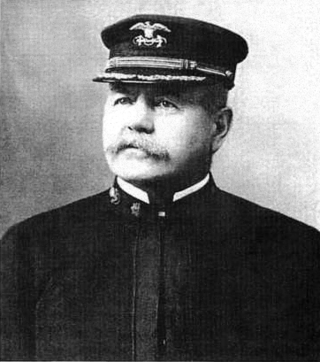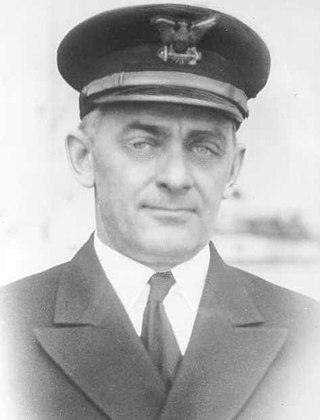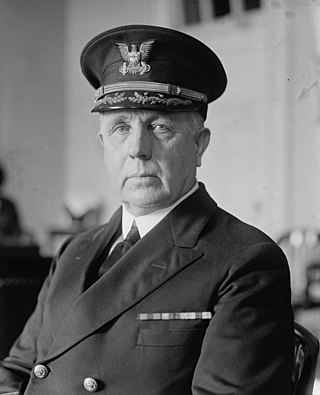
The United States Revenue Cutter Service was established by an act of Congress on 4 August 1790 as the Revenue-Marine upon the recommendation of Secretary of the Treasury Alexander Hamilton to serve as an armed customs enforcement service. As time passed, the service gradually gained missions either voluntarily or by legislation, including those of a military nature. It was generally referred to as the Revenue-Marine until 31 July 1894, when it was officially renamed the Revenue Cutter Service. The Revenue Cutter Service operated under the authority of the U.S. Department of the Treasury. On 28 January 28 1915, the service was merged by an act of Congress with the United States Life-Saving Service to form the United States Coast Guard.

Frank Hamilton Newcomb was a United States Revenue Cutter Service commodore, best known for his actions at the Battle of Cárdenas during the Spanish–American War.

Elmer "Archie" Fowler Stone was a United States naval aviator and a commander in the United States Coast Guard.

Harry Gabriel Hamlet was the seventh Commandant of the United States Coast Guard, from 1932 to 1936.

William Edward Reynolds served as the fifth Commandant of the United States Coast Guard, from 1919 to 1924.

United States Coast Guard Cutter is the term used by the U.S. Coast Guard for its commissioned vessels. They are 65 feet (19.8 m) or greater in length and have a permanently assigned crew with accommodations aboard. They carry the ship prefix USCGC.
USRC Walter Forward was a schooner constructed for service with the United States Revenue Marine. She was more commonly known as USRC Forward. Forward served with the U.S. Army and U.S. Navy in Mexican waters during the Mexican–American War and was commended for her actions during the Tabasco River landings by Commodore Matthew C. Perry, U.S. Navy. After the war, she was transferred to the U.S. Coast Survey for a short time as USCS Walter Forward before being returned to the Revenue Marine for service during the 1850s and the American Civil War.

USRC Seminole was a 188 ft (57 m), 845-ton United States Revenue Cutter Service steamer constructed by the Columbian Iron Works in Baltimore, Maryland for $141,000. She was commissioned in 1900 and saw service through 1934, when she was transferred to the Federal Emergency Relief Administration.
USRC Tench Coxe was a 39-ton harbor steam-powered vessel that was built by William T. Malster, in Baltimore, Maryland. Her contract price was $14,800 and the cutter was to "be delivered at Philadelphia." She was launched on 7 June 1876 and arrived at her home port of Philadelphia on 16 September 1876. On 23 October her first commanding officer, Revenue Captain (Acting) Eric Gabrielson, was ordered to place the cutter in commission and to "ship crew." Captain Gabrielson placed the Tench Coxe in commission on 27 October 1876.
One of the first ten revenue cutters, Active may have been the second of the ten cutters to enter service. The Columbian Centinel on 30 April 1791 noted:
A Revenue Cutter, was launched at Baltimore the 9th inst. at Captain Stodder's Ship Yard, and is considered by good judges, a beautiful vessel. She is to be commanded, we hear, by Capt. Gross, formerly First-Lieutenant of the Continental Frigate CONFEDERACY.
USRC General Green was one of the first ten cutters operated by the U.S. Revenue Cutter Service. She was named for the Revolutionary War hero Major General Nathanael Greene. Her name was misspelled, probably by the man who oversaw her construction, the Collector of Customs in Philadelphia, Sharp Delany. Apparently the cutter was to have been originally named for the Secretary of the Treasury, Alexander Hamilton, but Delany changed the name for reasons unknown.

USRC Massachusetts was one of the first ten cutters operated by the Revenue-Marine. She was built in Newburyport, Massachusetts and served out of Boston. Massachusetts by tradition is held to be the first revenue cutter to enter active service. She was also the first to be decommissioned, having a very short service life of only about 15 months before being sold.
USRC Scammel was one of the first ten cutters operated by the United States' Revenue Cutter Service.
USRC Argus was one of the first ten cutters operated by the United States' Revenue Cutter Service. Of the ten cutters, she was the longest to serve in this role.
USRC South Carolina was one of the first ten cutters operated by the United States' Revenue Cutter Service.
USRC Eagle was one of the first ten cutters operated by the United States Revenue-Marine, which later became the United States Revenue Cutter Service and later still became part of the United States Coast Guard.

Hopley Yeaton was the first officer commissioned under the Constitution of the United States by George Washington into the Revenue Marine, one of the forerunners of the modern-day United States Coast Guard. The Coast Guard was created when Congress merged the Revenue Cutter Service with the U.S. Lifesaving Service in 1915.

USRC Mohawk, was a steel steam powered revenue cutter built for the U.S. Revenue Cutter Service by William R. Trigg Company at Richmond, Virginia. Her primary duties in the Revenue Cutter Service and Coast Guard were assisting vessels in distress and enforcing navigational laws as well as a derelict destroyer. Mohawk was sunk after a collision with another vessel in October 1917.
The capture of the schooner Bravo was a naval battle fought in 1819 between United States Revenue Cutter Service cutters and one of Jean Lafitte's pirate ships.

Massachusetts II was a small sloop operated by the Revenue-Marine used in the collection of customs duties. She was completed in June 1793 and replaced Massachusetts, one of the first ten cutters of the Revenue-Marine, when it was determined that the older ship was too large and slow to perform her assigned tasks. Massachusetts II was constructed by Adna Bates of Cohasset, Massachusetts for a cost of US$1,600. Her area of operation was along the Massachusetts coast as a smaller less expensive replacement to the original Massachusetts. When the original Massachusetts was sold at auction, the second and third mates were discharged and Massachusetts II was crewed by two officers and four sailors.









